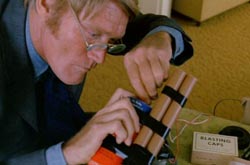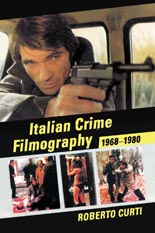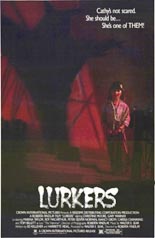
 Ever since she was a 10-year-old blonde, the brunette Cathy has seen visions throughout New York City. In the day, it could be a granola-looking woman wrapped in thrift-store duds or a little girl who looks like she came in fourth place in the Heather O’Rourke look-alike contest. In the night, however, Cathy sees Lurkers: superimposed faces and bodies of “horrible old people” surrounding her bed.
Ever since she was a 10-year-old blonde, the brunette Cathy has seen visions throughout New York City. In the day, it could be a granola-looking woman wrapped in thrift-store duds or a little girl who looks like she came in fourth place in the Heather O’Rourke look-alike contest. In the night, however, Cathy sees Lurkers: superimposed faces and bodies of “horrible old people” surrounding her bed.
Nonetheless, Cathy (Christine Moore, Prime Evil) survives such hauntings — not to mention abuse from and nearly getting stabbed by her shrew of a mother — and becomes a professional cello player who enjoys sexual congress with her fiancé, Bob (Gary Warner, also from Prime Evil), a photographer who looks like Lou Reed. Although she thinks he’s the bee’s knees because he “protects” her while she sleeps, Bob is really a cad who’ll stain the sheets of anything with fallopian tubes. And you think the elderly are horrible, Cathy?
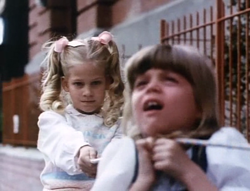 As becomes increasingly obvious to everyone but our big-haired heroine, Bob is involved in some deeply sordid dealings. Such acts come to light approximately at the point of Lurkers when, out of nowhere, a beefy man with a sledgehammer (Tom Billett, Bad Girls Dormitory) appears and flattens the melon of a random screaming woman in the streets. Cathy witnesses this, then immediately attends a party where no one believes her likely story.
As becomes increasingly obvious to everyone but our big-haired heroine, Bob is involved in some deeply sordid dealings. Such acts come to light approximately at the point of Lurkers when, out of nowhere, a beefy man with a sledgehammer (Tom Billett, Bad Girls Dormitory) appears and flattens the melon of a random screaming woman in the streets. Cathy witnesses this, then immediately attends a party where no one believes her likely story.
That’s when director Roberta Findlay (of, yep, Prime Evil) seems to have tired of the course her film heretofore has taken for a good hour or so and switches gears. This could be because across her decades of work, Findlay is not known for having much use for story, which Lurkers actually possesses — okay, so it’s in piecemeal, but a start is a start. Her touch is all over this one: rough setups, questionable angles and unbalanced performances.
For what it is, Lurkers looks pretty good, benefitting from the decade’s love of bright colors; therefore, I suspect it’s visually sturdier than Findlay’s porn work, although one can sense this movie could become an X-rated pomp at any moment. After all, on display are pink sheets, overgrown ferns, crucified homosexuals in bondage gear and, above all else, lingerie models talking junk bonds and index futures while undressing. —Rod Lott

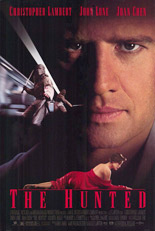
 A computer-chip salesman walks into a bar. We’ll call him Paul. He’s a New Yorker in Tokyo for business, but now it’s time for pleasure, so he sidles up beside a pretty local girl and starts chatting her up. She drinks too much sake and he offers to take her to dinner and a drum concert. Later that night, he walks her back to her hotel room like a gentleman and starts to leave. But she tells him to stay, so he does. She strips him down to his boxers, which have pictures of “piggies” on them. But she has steamy sex with him, anyway, right there in the room’s built-in hot tub. After orgasm, she’s decapitated by a ninja. I guess that’s the punch line.
A computer-chip salesman walks into a bar. We’ll call him Paul. He’s a New Yorker in Tokyo for business, but now it’s time for pleasure, so he sidles up beside a pretty local girl and starts chatting her up. She drinks too much sake and he offers to take her to dinner and a drum concert. Later that night, he walks her back to her hotel room like a gentleman and starts to leave. But she tells him to stay, so he does. She strips him down to his boxers, which have pictures of “piggies” on them. But she has steamy sex with him, anyway, right there in the room’s built-in hot tub. After orgasm, she’s decapitated by a ninja. I guess that’s the punch line. 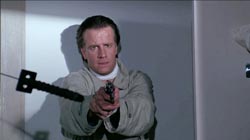
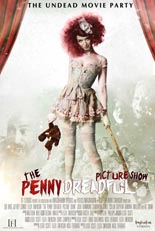
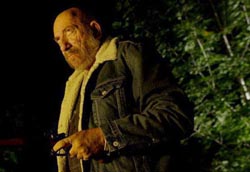 Up first is “Slash in the Box,” woefully short, yet dead-on in recapturing that
Up first is “Slash in the Box,” woefully short, yet dead-on in recapturing that 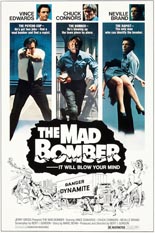
 Although known for movies with overgrown critters (i.e.
Although known for movies with overgrown critters (i.e. 